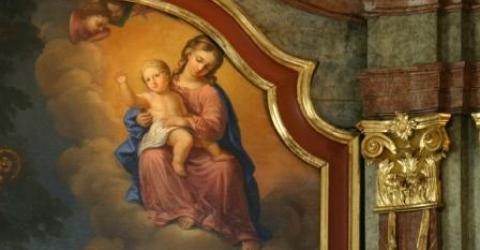For over sixteen-hundred years the birth of Christ has been celebrated on December 25th, even though for the church’s first three centuries, Christmas wasn’t in December, or on the calendar at all.
There has been much time and attention given to searching the scriptures n an attempt to find ‘the date’ in which Jesus was actually born. One in depth study even places the birth of The Christ Child around September 3BC. The September –3 BC comes from a study "The Birth of Christ Recalculated". The author, Dr. Ernest L. Martin, claims to have calculated the exact date of Jesus Christ’s birth based on the celestial charts for that era. The date of Christ’s birth, based on the famous Star of Bethlehem, is calculated to be September 11, 3 B.C..
Many biblical scholars, theologians, historians, and astronomers say that the Star of Bethlehem, signifying the birth of Jesus Christ, can be calculated to within a few hours of September 11, 3 B.C., based on celestial charts and alignments for that time. Historian Dr. Ernest L. Martin first article on the subject appeared in 1976, and in 1981 he published his research in "The Birth of Christ Recalculated". In 1991, the book was re-released as "The Star that Astonished the World." Dr. Martin revealed in his book, that the signs in the sky on the night of Jesus’ birth occurred on only one day in 3 B.C., and they occurred exactly on September 11, 3 B.C. between 6:15 pm and 7:49 pm EST.
One of the scriptural links to Ernest Martin’s study is found in the book of the Revelation 12:1-2
“And there appeared a great wonder in heaven; a woman clothed with the sun, and the moon under her feet, and upon her head a crown of twelve stars: And she being with child cried, travailing in birth, and pained to be delivered. “ Revelation 12:1-2
The astronomical synchronism of this sign by supposition occurred in the year of Christ’s birth in 3 BC.
-
Virgo occupies, in body form, a space of about 50 degrees along the ecliptic (The head of the Woman actually bridges some 10 degrees into the previous sign of Leo and her feet overlap about 10 degrees into the following sign of Libra the Scales].
-
In the year of Christ’s birth, the Sun entered the head-position of the Woman about August 13, and exited her feet about October 2.
-
But the apostle John saw the scene when the Sun "clothed" the Woman" (to be mid-bodied], and this happens between about 150 and 170 degrees along the ecliptic, which occurs over about a 20-day period each year, which in 3 BC was from about 27 August and 15 September.
-
If John in the Book of Revelation were associating the birth of Christ with the period when the Sun is mid-bodied to the Woman, then Christ would have been born within this 20 day period. From the point of view of the Magi back in their homes in Babylon, this would have been the only logical sign under which the Jewish Messiah might be born. Especially if He were to be born of a virgin [Even today, astrologers recognize that the sign of Virgo is the one which has reference to a messianic world ruler to be born of a virgin. Devore, Ency. of Astrology, p. 366]. http://www.versebyverse.org/doctrine/birthofchrist.html
Now to be sure the spiritual air is relatively clear, there is nothing in the ‘Holy Scriptures’, at least considered black & white, that would validate this September 11, 3 B.C. date, so one can only base these findings on supposition at best.
So if December 25th is NOT the actual day of Jesus’ birth, where did that date come from?
“In 274 A.D., the Romans designated December 25 as the birthday of the unconquered sun, being the time when the sun begins noticeably to show an increase in light, resulting in longer daylight hours. By 336 A.D., the church in Rome was adapting this festival, spiritualizing its significance as a reference to Jesus Christ and calling it the ‘Feast of the Nativity of the Sun of Righteousness.’ Attempting to Christianize and incorporate the pagan traditions of antiquity, the church in Rome adopted this midwinter holiday celebrating the birth of the sun god as one of its own observances, somewhat changing its significance, but retaining many customs of the pagan festival. As the Roman church spread its influence religiously and militarily, this holiday of December 25 became the most popular date in Christendom to celebrate the birth of Jesus Christ. A special mass was established for Christ, hence, the name, ‘Christmass,’ abbreviated ‘Christmas.’” Promised Seed of Christ
The pagan origins of the December 25th Christmas date, as well as many of the customs associated with our modern day celebration (feasting, partying, gift giving, etc.…) of Christmas, were also associated with the Roman Saturnalia to honor the god Saturn.
Many of the decorations characteristic of the Saturnalia celebration involved greenery – swathes, garlands, wreaths, etc… and were hung over doorways and windows, and adorned stair-ways. http://en.wikipedia.org/wiki/Saturnalia
Ornaments in the trees included various articles of decorations, sun symbols, stars, and faces of the god Janus (the god of gates and door, beginnings and endings). Trees were not brought indoors (indoor Christmas trees began as a German tradition), but decorated where they grew. Even the hanging of mistletoe and burning of the Yule logs, were part of the pagan holiday. http://www.novaroma.org/religio_romana/saturnalia.html
When one considers the origin and celebrations associated with the Roman Saturnalia, it is pretty obvious that “Christmas”, and thereby its seeming association to the birth of Jesus Christ, is nothing more than "paganism wrapped with a Christian bow" or “the mixing of oil and water” the naysayers argue. The sad truth is, that the pagan aspect, (fleshly and selfish appetites) have become the reason for the season instead of the worthy recognition of the fact that God became a man.
So what are we to do?
Was the church for the first three centuries correct?
Due to the fact that God in His word, has not given us the exact date of Jesus’ birth, should the body of Christ abstain from any type of Christmas celebration?
“The life of man is a continual death, unless it be that Christ lives in him.”
—Ignatius
It is paramount for one to understand that Jesus Christ was born to die. The Creator taking on Himself flesh and blood that He might die for the SIN of His creation. Could this be the reason He confirmed, to the exact date, His death and not His birth?
As Ignatius is alluding to, it is the same for the creation… we are born to die.
“It is appointed unto men once, to die, then the judgment of God”.
If a man trust in this Christ he shall never die… believeth thou this?
We might do well to consider this as we go about our celebration of Christmas. It is more about one’s attitude than all the decorations or even the celebration itself, as God looks not on the outward appearance but at the content of the heart.
My only thoughts on this is “let no man therefore judge you in meat, or in drink, or in respect of an holy-day, or of the new moon, or of the sabbath days.” So whatever you do, do it for the honor of Christ.
"Hear the angels, as they’re singing
On the morning of His birth!
But how much greater will our song be
When He comes again to earth!"
MERRY CHRISTMAS
Brother Malachi
Leave a comment
No comments yet.



![aaPersecution Blog [VOM]](http://i1375.photobucket.com/albums/ag451/brother_malachi/22e98d19-6563-49a9-b63b-75150a24dcc0_zps2eefc67e.jpg)




Leave a comment